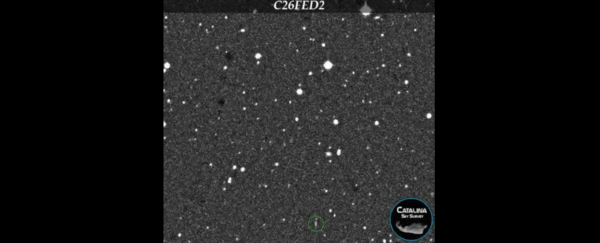In the skies above Earth, astronomers with the Catalina Sky Survey have spotted what might be a new friend: an asteroid temporarily captured by our planet's gravity, what we call a minimoon.
It's named 2020 CD3, a small chunk of likely carbonaceous rock between 1.9 and 3.5 metres (6.2 and 11.5 feet) in diameter. And here's the kicker - the rock's trajectory indicates it's been in orbit for around three years already.
The near-Earth neighbourhood is a relatively busy place, with boatloads of asteroids zipping past. The precise numbers, however, are unclear; estimates put the number at millions, but as of February 25, the number discovered was only 22,211.
That's because asteroids are really small, we don't know where they are (so we don't know where to look), and they typically don't give off a lot of light, even when they're reflecting sunlight.
You'd think that, with so many rocks flying around, they'd get slurped up by Earth's gravity all the time. Well, they do; but most of them don't hang around long enough to become minimoons.
These briefly captured space rocks either head straight into the atmosphere, where they are burned up on entry, becoming spectacular fireballs; or they skim around for a partial orbit before their velocity carries them onwards and upwards.
It's only the smallest number of passing space rocks that are likely to become minimoons. According to a 2012 supercomputer simulation including 10 million virtual asteroids, only 18,000 got captured in Earth orbit.
So not only are they hard to spot, they are super-rare. There have been several candidates for minimoons, including two fireballs with slow velocities that implied an orbital origin, but only one confirmed - an asteroid called 2006 RH120 that orbited Earth for about a year from 2006 to 2007. (Another potential minimoon, 469219 Kamoʻoalewa, turned out to be in orbit around the Sun near Earth, and therefore a quasi-satellite).
So 2020 CD3 is a bit of a big deal. Not just because its rarity makes it something of a celebrity, but because minimoons offer an exciting opportunity for asteroid exploration.
Sending spacecraft to asteroids is an expensive and time-consuming endeavour, and often involves vast distances. If an asteroid is just hanging around Earth for a spell, that would make for a much easier target.
Here's an animated GIF of our new mini-moon 2020 CD3, discovered by @WierzchosKacper. Rotating frame keeps the Earth/Sun line stationary. Orbital elements courtesy of IUA MPEC. https://t.co/dok3jn3G9hhttps://t.co/x1DXWLq2vm pic.twitter.com/O3eRaOIYjB
— Tony Dunn (@tony873004) February 26, 2020
It's likely actually too late for 2020 CD3 specifically, sadly. According to an orbital simulation, our little minimoon friend will be on its way out of Earth orbit by April 2020. It is possible, however, that the simulation is incorrect, so observation is ongoing.
Either way, by studying our minimoon's strange looping orbit, we can learn more about how these objects are captured by Earth, and how we can better look for them in the future.
